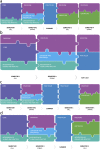MPH education for the 21st century: design of Columbia University's new public health curriculum
- PMID: 24228682
- PMCID: PMC3910049
- DOI: 10.2105/AJPH.2013.301518
MPH education for the 21st century: design of Columbia University's new public health curriculum
Abstract
Because public health challenges are changing rapidly, over the past 3 years, we have turned a critical eye to the master of public health program at the Columbia University Mailman School of Public Health. Under a process dubbed "curriculum renewal," we engaged more than 170 faculty, staff, and students (and hundreds of alumni and employers of our graduates) in an initiative to develop a completely new design for master of public health education that launched in fall 2012. We have described its design and structure and presented some preliminary evaluation data.
Figures



Comment in
-
Applied public health training: a graduate's perspective.Am J Public Health. 2014 Jun;104(6):e1. doi: 10.2105/AJPH.2014.301913. Epub 2014 Apr 17. Am J Public Health. 2014. PMID: 24825221 Free PMC article. No abstract available.
References
-
- Zerhouni E. The NIH roadmap. Science. 2003;302(5642):63–72. - PubMed
-
- Frenk J, Chen L, Bhutta ZA et al. Health professionals for a new century: transforming education to strengthen health systems in an interdependent world. Lancet. 2010;376(9756):1923–1958. - PubMed
-
- Roy R. Interdisciplinary science on campus—the elusive dream. Chem Eng News. 1977;55(35):28–30.
-
- Committee for the Study of the Future of Public Health Division of Health Care Services. The Future of Public Health. Washington, DC: Institute of Medicine; 1988.
MeSH terms
LinkOut - more resources
Full Text Sources
Other Literature Sources
Miscellaneous

